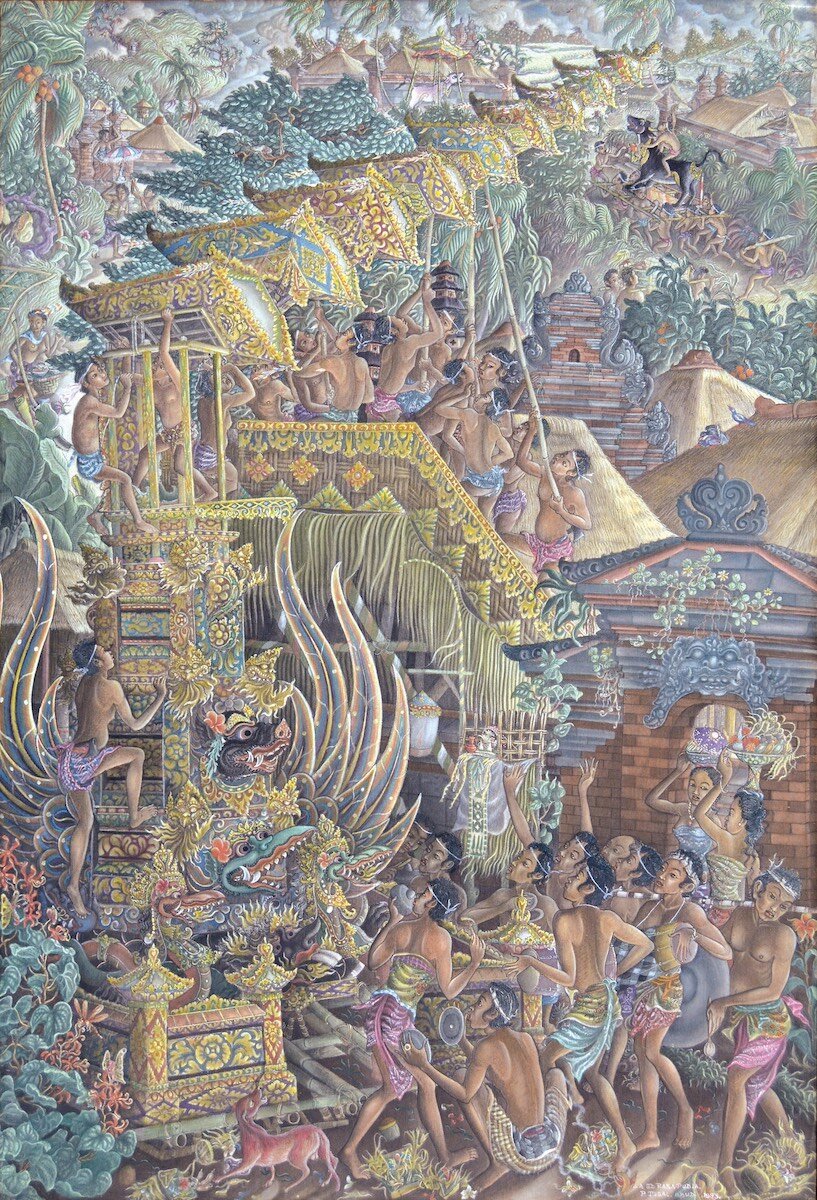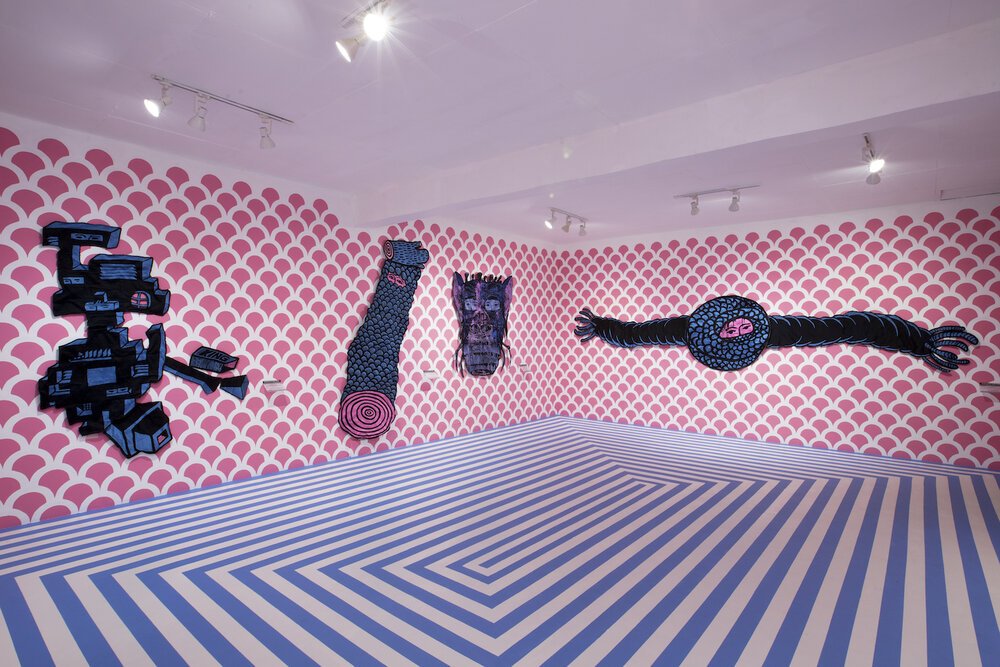Larasati October Auction Report
The Balinese art market right now
By Richard Horstman
The market for Balinese paintings, often labelled “traditional”, is a small niche sector in comparison to the broader Indonesian modern and contemporary art market. While Indonesian collectors dominate, there is an upward trend of foreign buyers entering the market that is currently showing signs of growth.
Ida Bagus Rai, ‘Pandawa dalam Pengasingan’’, 1969, acrylic on canvas, 165 x 110cm. Image courtesy of Larasati Auctioneers.
In 2006, Larasati Auctioneers of Jakarta opened up an international forum for the trade of high-quality Balinese art. They began by presenting two auctions per year in Ubud specialising in Balinese paintings, which has helped revived a declining market. Works by some of the masters of the famous Pita Maha Artists Association established in Ubud in 1936 are Ida Bagus Made Poleng, Gusti Nyoman Lempad, Anak Agung Gede Sobrat, Ida Bagus Made Nadera and Gusti Ketut Kobot. These have proven especially popular with collectors.
Balinese painting has many genres, beginning with the ancient, sacred narrative Classical style displayed in the temples and the houses of the aristocracy. These works are also referred to as Wayang paintings, for their iconography and narratives are derived from the Wayang Kulit shadow puppet theatre. They came to be known as Kamasan paintings, from the village in Klungkung, East Bali that was the epicentre of Balinese art from the 16th to 20th century.
Other genres evolved between 1920 and 1980 from the Classical style. The Batuan paintings developed their distinct visual features and techniques outside of the modern western influences accredited to Walter Spies (1895 – 1942) and Rudolf Bonnet (1895 – 1978), who were instrumental in the birth of the renowned Ubud School of Painting in the late 1920s. Other village styles, or schools developed: Sanur, Pengosekan, Young Artists and Keliki. These are created alongside wood carvings from the village of Mas. The golden years of Balinese painting were from 1930 to 1945, in an era that witnessed technical and stylistic innovations along with the first tourism boom in Bali. The second wave of tourism began in the 1970s, and the popularity of Balinese painting increased, especially after 1980, in alignment with the national government’s policy of cultural tourism.
A key reason leading to Balinese art being underappreciated and undervalued has been the general perception of the genre. It is often maligned and referred to as “tourist” and folk art, or a craft without a rightful place within Indonesian art history. In fact, some of the finest practitioners of Balinese painting, past and present, are from the Balinese high castes. Ida Bagus Made Poleng (1915 – 1999) for example, is considered the most influential artist from the 20th century, and is from the Brahmin high caste, and the most cherished living painter is Anak Agung Gede Anom Sukawati (b. 1966), who is also from an upper caste. Therefore, it is not an art form of ordinary people.
Balinese art was collected by the Dutch during the colonial occupation (1840 – 1950) and exhibited in anthropological museums of the Netherlands. It was not presented in the renowned art museums of Europe that would have endorsed the relevance and value of Balinese painting within the context of world art. It was, however, displayed within the anthropological museums with demeaning colonial narratives, referred to as art made by the primitive people of Bali.
The institutional landscape for Balinese art has recently undergone significant change. Two institutions with the most important collections of Balinese art have been rebranded and renamed Museums of World Culture: the Volkenkunde Leiden Museum, Leiden, the Netherlands and the World Museum Vienna, Weltmuseum Wien, Austria. The Volkenkunde Leiden Museum recently began purchasing Balinese paintings afresh, including six works by emerging Batuan artists Wayan Aris Sarmanta and Wayan Budiarta, and exhibited them in a ground-breaking exhibition of art and culture titled ‘Welcome to Paradise’, which opened in May 2019. It signified a break from old narratives of Balinese art, with special curatorial attention given to its significance within art history. These factors will impact positively upon its perception and appreciation internationally, and importantly within Indonesia.
Wayan Djudjul, ‘Suasana Pasar’, date unknown, acrylic on canvas, 85 x 55cm. Image courtesy of Larasati Auctioneers.
For the first time in its thirteen-year history, Larasati conducted their third auction in Ubud within the year. The recent Modern, Traditional and Contemporary Art Auction was held on 12 October at the Larasati Art Space, Tebesaya Gallery, Ubud, Bali. The painting featured on the cover of the Larasati catalogue incited the most enthusiastic bidding of the day. Lot 792 ‘Pandawa dalam Pengasingan’ (Pandawa in Exile), executed in 1969, by Ida Bagus Rai (1933 – 2007) hammered at IDR 160 million, dramatically increasing more than 500% from its estimated price of between IDR 25 to 30 million. Another strong result was Lot 717 ‘Suasana Pasar’ (Market Atmosphere) by Wayan Djudjul (1942 – 2008), with an estimate of between IDR 28 – 38 million. It eventually sold for IDR 76 million, an increase of around 100%. A work by one of the distinct innovators within the Ubud School, Dewa Putu Mokoh (1934 – 2010), Lot 739 ‘Jemur Pakaian’ (Drying Clothes), painted in 2001, sold above the estimate of IDR 15 – 18 million at IDR 22 million.
Dewa Putu Mokoh, ‘Jemur Pakaian’, 2001, acrylic on canvas, 80 x 60cm. Image courtesy of Larasati Auctioneers.
Although 30% of the lots were unsold, it did reveal a continuing demand for the signature works by established masters of the Ubud School of Painting, with all significant works sold. For example, there were four paintings, Lots 780 to 783 by Anak Agung Raka Puja (1936 – 2016) on offer. The two works in his older style of daily life village scenarios did not sell, while Lots 82 and 783 ‘Mendirikan Menara Bade’ (Erecting the Cremation Tower), highlighted on the back cover of the Larasati catalogue, and ‘Melasti Ke Sakenan’ (Melasti Precession to Sakenen) were both sold at just under their estimated values of IDR 130 million and IDR 75 million respectively.
Anak Agung Gede Raka Pudja, ‘Mendirikan Menara Bade’, 1983, acrylic on canvas, 114 x 79cm. Image courtesy of Larasati Auctioneers.
Two paintings by Wayan Kayun (b. 1954) were offered, yet only Lot 777 ‘Persiapan Ngaben’ (Preparation for a Cremation) in the artist’s signature culturally themed style was purchased, hammering at IDR 110 million. Works by the recently deceased master of the Batuan miniature style Ketut Murtika (1952 – 2019): Lot 785 ‘Perang Tanding Arjuna Melawan Karna’ ( Arjuna's Fight Against Karna) and Lot 786 ‘Ramayana Scene’, both mythological narratives, were purchased within their estimated values, for IDR 15 million and IDR 18 million respectively.
There are initiatives spurning renewed development of Balinese art. TiTian Bali Art Foundation opened in Ubud in 2016 and is an artist incubator specialising in identifying and nurturing emerging talent and introducing the best artists to the market. Exciting young talent is appearing in the village of Batuan, such as the previously mentioned Sarmanta and Budiarta, along with Pande I Made Dwi Artha and Gede Widyantara, as well as Keliki village artists such as Putu Kusuma and Putu Adi, supported by well-organised art collectives such as Baturlangun in Batuan and the Werdi Jana Kerti Artists Association in Keliki.
The Larasati auctions offer opportunities to purchase Balinese paintings more accessibly than from artist’s studios and galleries, providing an entry point for first-time buyers who may be working with smaller budgets, especially with an easily navigable website indicating past auction results as well as the option for online live bidding. The Balinese market is undervalued with strong potential and opportunities available to collectors with a long-term view willing to buy and hold for 10 to 15 years to wait for the market to mature for profit-making.

















